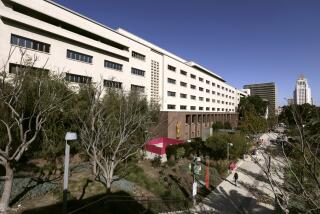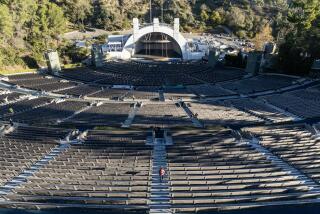Landmark Old Cottages Crumbling in Neglect
Bungalow Village, a nationally designated historical preserve of 13 cottages adjacent to the Hollywood Bowl, has fallen into disrepair, beset by vandals and neglect.
In house after house, windows are boarded up, doors are broken and shrubbery is dying. Vandals have set fire to one cottage. Inside another, an oak mantel and lead glass cupboard doors are missing. At times, cars have been abandoned inside the courtyard.
“The buildings are rotting,” said Ron Max, a bungalow tenant who led the campaign for historical landmark designation four years ago. “I have loved living here, and seeing the buildings fall apart is like seeing an old friend die.”
Better Protection Urged
The deterioration of the county-owned Bungalow Village--a unique hamlet once home to working-class artists, musicians and actors--has sparked concern among Hollywood community leaders and preservationists.
They are demanding that Los Angeles County better protect the buildings to stave off further decay.
The 13 cottages were built between 1918 and 1923, clustered on the hillside around a spacious courtyard. The wood-frame dwellings, at the corner of Highland Avenue and Camrose Drive, are connected by cobblestone walkways and stairsteps and shaded by towering trees and thick bamboo bushes.
Nowhere else in the nation can such an arrangement of old California bungalows be found, said Lucinda Woodward, a historian with the state Office of Historic Preservation.
In its heyday, the neighborhood was home to aspiring young musicians, actors and members of Hollywood’s fledgling film industry, who used the courtyard as their rehearsal stage. An old post still stands were tenant messages were posted.
“It was a rustic village, an affordable place to live,” Woodward said.
And it remained that way for decades.
“It’s rare that anyone in Los Angeles could live in a place like this,” said Andrea Dietrich, a five-year tenant and cinematographer. “Everyone knew each other, writers, musicians, film people. We would talk about our future, our art.”
In 1985, Jan Development Co. purchased the property with plans to level the village for a 220-unit apartment complex. Led by Max, residents mounted a successful drive for city landmark status, which can stop demolition of historic places. Later the site won a slot on the National Register of Historic Places.
In 1987, Los Angeles County Supervisor Ed Edelman stepped in, envisioning the site as a Hollywood Bowl picnic space. The community supported the county’s purchase of the site for $2.8 million.
As tenants gradually moved out, the county did not re-rent the units, opting instead to seal them up. Today only two bungalows are occupied.
“The county is not in the business of being a landlord,” said Richard Andino, chief of the real estate division. “We did not acquire them to rent them out; we acquired them to refurbish the area into a park.”
Residents and preservationists have yet to embrace the county’s preliminary proposal to demolish half of the 70-year-old bungalows to make room for the picnic grounds. The remaining dwellings would be transformed into offices for the Los Angeles Philharmonic.
Environmental Study
A state-mandated environmental review of the park-office plan as well as alternative development proposals is under way, but will not be completed until early next year. It will take at least another year before a final plan is adopted and construction can begin, county officials said.
“Who knows . . . how much longer it will take to get funding to renovate the place,” Max said. “We just don’t want the bungalows to get to a point where none of the buildings are salvageable.”
Community leaders contend that the current method of protection--boarded windows and barbed wire fencing--is doomed to backfire because abandoned buildings invite transients, arsonists and vandals. Further degradation of the site, they said, would make it more difficult and expensive to renovate.
They essentially want the county to scrap their boards and barbed wire and instead make the bungalows look like occupied buildings. They want curtains hung and a fresh coat of paint on the building facades. They want new landscaping, automatic lights and hourly security patrols. They also want the last two tenants to live at the site as long as possible.
“We feel very strongly that buildings that look occupied and are occupied are our best protection,” said Fran Offenhayser, a preservation architect and member of the Hollywood Heights Homeowners Assn.
Beginning in November, the site will be patrolled by Hollywood Bowl park rangers, and a county caretaker has moved into one bungalow, Edelman’s aide said. The supervisors will decide soon what other protective measures, if any, to take, the aide said.
The 4-acre parcel is considered a critical piece of Hollywood real estate and its future development will affect surrounding neighborhoods as well as the ambience of one of Southern California’s cultural landmarks, the Hollywood Bowl, activists said.
“This is a gateway into Hollywood and the Bowl,” said Jess Chusid, president of the Hollywood Heights Homeowners Assn. and a board member of Hollywood Heritage, a 3,500-member preservation group. “Whatever happens will be symbolic for our community because it will represent what Hollywood has been and where it is headed.”
Fresh in the minds of many activists is a fire last May that destroyed the historic Pan Pacific Auditorium, which also was a county-owned landmark slated for renovation.
“This is an absolute parallel to the Pan Pacific situation,” Offenhayser said. “The county moves slowly. But without interim preservation and stabilization, the buildings are targets for all kinds of nasty things.”
More to Read
Sign up for Essential California
The most important California stories and recommendations in your inbox every morning.
You may occasionally receive promotional content from the Los Angeles Times.






